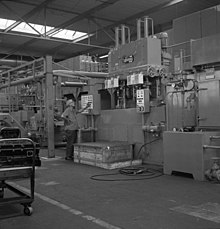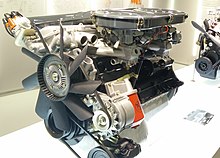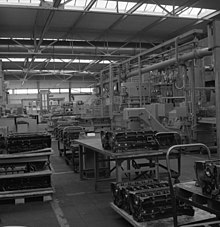BMW M30
| BMW | |
|---|---|
|
M30 with carburetors |
|
| M30 | |
| Production period: | 1968-1994 |
| Manufacturer: | BMW |
| Working principle: | Otto |
| Motor design: | Inline six-cylinder |
| Valve control: | OHC |
| Displacement: | 2494-3430 cm 3 |
| Mixture preparation: | Carburettor or manifold injection |
| Engine charging: | None except for the turbocharger in the BMW E23 745i |
| Power: | 110-185 kW |
| Previous model: | none |
| Successor: |
BMW M50 BMW M60 |

BMW M30 is the internal name for a series of six-cylinder - Otto engines of BMW with 2.5 to 3.5 liters displacement .
Conceptually, it goes back to the four-cylinder BMW M10 and contributed significantly to BMW's good reputation as a manufacturer of excellent six-cylinder engines . The engine was first used in 1968, at that time under different names, in the E3 or E9 series (including later CSL ), later mainly in the 5 , 6 and 7 series and remained in production until 1994. In later years, the smaller M20 six-cylinder was used in parallel for displacements of up to 2.7 liters . The four-valve versions M88 / S88 , based on the M30 engine block, were built until 1996.

The engine block with a cylinder distance of 100 mm is made of gray cast iron , the crankshaft has seven bearings.
The cross-flow cylinder head is made of light metal. The overhead camshaft , driven by a timing chain , in many versions a duplex chain, actuates two valves per cylinder . By varying the bore and the stroke , engines with 2.5; 2.8; 3.0; 3.2; 3.3 and 3.5 liters displacement.
Carburettors or manifold injection were used to form the mixture , digital engine electronics from 1979 for the 3.2 and 3.5 l versions, from 1986 in conjunction with catalytic converters . At the end of the 1970s, in the 5 series from the E28 1981, vertically arranged suction systems were used for weight reasons, cf. Images of injection versions. When the engine was presented in 1968, the combustion chamber, which was designed as a three-ball vortex pan with volume concentration around the spark plug, was new for a smooth combustion that was also favorable in terms of exhaust gases. This also protects the bearings. Turbocharged versions were also developed; the 745i came in series in the 1980s .
The M30 engine served as a tuning basis for companies such as Alpina , Hartge and Schnitzer .
The M30 was finally replaced by the BMW M50 (six-cylinder in-line engine, 24V) equipped with four-valve technology . For the BMW E32 was parallel to the eight-cylinder - V-engine BMW M60 continue the M30B30 offered (32V).
Data

| engine | Displacement | Bore × stroke | compression | Power at 1 / min | Torque at 1 / min | year |
|---|---|---|---|---|---|---|
| M30B25 | 2.5 l (2494 cm 3 ) | 86.0 mm × 71.6 mm | 9.0: 1 | 110 kW (150 PS) at 6000 | 211 Nm at 3700 | 1968 |
| M30B28 | 2.8 l (2788 cm 3 ) | 86.0 mm × 80.0 mm | 9.0: 1 | 125 kW (170 hp) at 6000 | 235 Nm at 3700 | 1968 |
| M30B28LE | 2.8 l (2788 cm 3 ) | 86.0 mm × 80.0 mm | 9.3: 1 | 135 kW (184 hp) at 5800 | 240 Nm at 4200 | 1979 |
| M30B30 | 3.0 l (2986 cm 3 ) | 89.0 mm × 80.0 mm | 9.0: 1 | 135 kW (184 hp) at 5800 | 255 Nm at 3500 | 1976 |
| 9.0: 1 | 138 kW (188 hp) at 5800 | 260 Nm at 4000 | 1986 | |||
| 9.2: 1 | 145 kW (197 hp) at 5800 | 275 Nm at 4000 | 1986 | |||
| M30B32 | 3.3 l (3210 cm 3 ) | 89.0 mm × 86.0 mm | 10.0: 1 | 145 kW (197 hp) at 5500 | 285 Nm at 4300 | 1979 |
| M30B33LAE | 3.3 l (3210 cm 3 ) | 89.0 mm × 86.0 mm | 7.0: 1 | 185 kW (252 hp) at 5200 | 380 Nm at 4000 | 1980 |
| M30B33LE | 3.3 l (3210 cm 3 ) | 89.0 mm × 86.0 mm | 9.0: 1 | 145 kW (197 hp) at 5500 | 280 Nm at 4300 | 1976 |
| M30B35 | 3.5 l (3430 cm 3 ) | 92.0 mm × 86.0 mm | 9.0: 1 | 155 kW (211 hp) at 5700 | 305 Nm at 4000 | 1986 |
| M30B35M | 3.5 l (3430 cm 3 ) | 92.0 mm × 86.0 mm | 8.0: 1 | 136 kW (185 PS) at 5400 | 290 Nm at 4000 | 1984 |
| M30B35M | 3.5 l (3430 cm 3 ) | 92.0 mm × 86.0 mm | 10.0: 1 | 160 kW (218 hp) at 5500 | 310 Nm at 4000 | 1982 |
| M30B35MAE | 3.5 l (3430 cm 3 ) | 92.0 mm × 86.0 mm | 8.0: 1 | 185 kW (252 hp) at 4900 | 380 Nm at 2200 | 1982 |
The weight of the engines is between 192 kg for the 2.5 l version for the BMW 525 from 1976, 199.5 kg for the engines in 3.0s / si, to 212 kg for the M30B35. The turbo versions weigh 225 kg.
use
M30B25
107/110 kW (145/150 hp)
- 1968–1977 in the BMW E3 2500
- 1972–1981 in the BMW E12 525
- 1974–1975 in the BMW E9 2.5 CS
- 1981–1987 in the BMW E28 525i
- 1981–1986 in the BMW E23 725i (for authorities and export)
M30B28
125 kW (170 hp)
- 1968–1971 in the BMW E9 2800 CS
- 1968–1977 in the BMW E3 2800
- 1972–1978 in the BMW E12 528
- 1973–1977 in the BMW E3 2.8 L
- 1977–1979 in the BMW E23 728
130 kW (177 hp)
- 1978–1979 in the BMW E12 528i
135 kW (184 hp)
- 1979–1981 in the BMW E12 528i
- 1981–1987 in the BMW E28 528i
- 1979–1987 in the BMW E24 628 CSi
- 1979–1986 in the BMW E23 728i
M30B30
132 kW (180 PS)
- 1971–1972 in the BMW E9 3.0 CSL
- 1971–1975 in the BMW E9 3.0 CS
- 1971–1977 in the BMW E3 3.0 S.
- 1973–1977 in the BMW E3 3.0 L
135 kW (184 hp)
147 kW (200 hp)
- 1971–1975 in the BMW E9 3.0 CSi
- 1972–1973 in the BMW E9 3.0 CSL (3003 cm³)
- 1972–1975 in the BMW E3 3.0 Si
143 kW (195 hp)
- 1975–1977 in the BMW E3 3.0 Si
138 kW (188 hp)
145 kW (197 hp)
- 1986–1992 in the BMW E32 730i
M30B32 (3153 cm³)
151 kW (206 hp)
- 1973–1975 in the BMW E9 3.0 CSL
M30B33
145/147 kW (197/200 hp)
M30B32LAE (Turbo without piston crown injection cooler .)
185 kW (252 hp)
- 1980–1983 in the BMW E23 745i
M30B35MAE (turbo with piston crown injection cooling )
185 kW (252 hp)
- 1983–1986 in the BMW E23 745i
M30B33LE
145/147 kW (197/200 hp)
M30B35LE
160 kW (218 PS, large bore, short stroke, 3453 cm³)
M30B35M
160 kW (218 PS, narrow bore, long stroke, 3430 cm³)
- 1981–1986 in the BMW E23 735i
- 1981–1987 in the BMW E28 S M535i
- 1981–1989 in the BMW E24 635 CSi
- 1986–1992 in the BMW E32 735i
- 1988–1992 in the BMW E34 535i (with dual mass flywheel)
M30B35M
136 kW (185 PS, works catalytic converter, normal fuel unleaded, 8: 1, 3430 cm³)
- 1984–1987 in the BMW E28 S M535i (1st BMW catalytic converter)
- 1984–1988 in the BMW E24 635 CSi cat.
- 1984–1986 in the BMW E23 735i Cat.
Four-valve versions based on the M30:
M30B35 / M88 (see separate article BMW M88 )
323 kW (440 hp)
- 1974–1975 in the BMW E9 3.0 CSL (racing version only)
588 kW (800 PS)
- 1975 in the BMW E9 3.0 CSL turbo (racing version only)
203 kW (277 hp)
- 1978–1981 in the BMW E26 M1
345 kW (470 hp)
624 kW (850 hp)
210 kW (286 hp)
- 1983–1988 in the BMW E24 M 635 csi ("M6")
- 1983–1988 in the BMW E28 M5
- 1983–1986 in the BMW E23 M745i (South African version)
S38B36 (see separate article BMW S38 )
231 kW (315 hp)
- S38B38
250 kW (340 hp)
Web links
Individual evidence
- ↑ a b c Karlheinz Lange: History of the engine - engine of history (BMW dimensions 1 + 2) . Ed .: BMW Mobile Tradition. 1st edition. tape 2 (1945-2000) , 1999, ISBN 3-932169-04-2 , Chapter 11: Engines of the New Class, p. 184.195 .
- ↑ a b c d e BMW AG (Ed.): BMW six-cylinder models . Press release. September 25, 1968 ( bmw-grouparchiv.de [accessed on May 7, 2018] archive signature UP-398-10).
- ^ Karlheinz Lange: History of the engine - engine of history (BMW dimensions 1 + 2) . Ed .: BMW Mobile Tradition. 1st edition. tape 2 (1945-2000) , 1999, ISBN 3-932169-04-2 , Chapter 18: Engines for series vehicles from M GmbH, p. 413 .
- ↑ a b c d Karlheinz Lange: History of the engine - engine of history (BMW dimensions 1 + 2) . Ed .: BMW Mobile Tradition. 1st edition. tape 2 (1945-2000) , 1999, ISBN 3-932169-04-2 , Chapter 20: Data, facts, engine directory, p. 512-513 .
- ↑ Hans J. Schneider: BMW 5 Series - Technology + Types: The sedan and touring models of the BMW 5 Series . Delius Klasing, Bielefeld 2007, ISBN 978-3-7688-5789-5 ; Page 75.
- ^ Karlheinz Lange: History of the engine - engine of history (BMW dimensions 1 + 2) . Ed .: BMW Mobile Tradition. 1st edition. tape 2 (1945-2000) , 1999, ISBN 3-932169-04-2 , Chapter 11: Engines of the New Class, p. 208 .
- ↑ Hans J. Schneider: BMW 5 Series - Technology + Types: The sedan and touring models of the BMW 5 Series . Delius Klasing, Bielefeld 2007, ISBN 978-3-7688-5789-5 ; Page 76.
- ↑ a b c d e focus.de, January 16, 2017: Tradition 40 Years of the BMW 7 Series , accessed on May 7, 2018.
- ↑ a b Hans J. Schneider: BMW 5 Series - Technology + Types: The sedan and touring models of the BMW 5 Series . Delius Klasing, Bielefeld 2007, ISBN 978-3-7688-5789-5 ; Page 129.
- ↑ Heinz-Peter Schmitz: Details BMW 745i South Africa version January 28, 2007, accessed June 23, 2017
| Timeline of BMW gasoline engines for passenger cars since 1961 | ||||||||||||||||||||||||||||||||||||||||||||||||||||||||||||
|---|---|---|---|---|---|---|---|---|---|---|---|---|---|---|---|---|---|---|---|---|---|---|---|---|---|---|---|---|---|---|---|---|---|---|---|---|---|---|---|---|---|---|---|---|---|---|---|---|---|---|---|---|---|---|---|---|---|---|---|---|
| Number of cylinders | Conception | 1960s | 1970s | 1980s | 1990s | 2000s | 2010s | |||||||||||||||||||||||||||||||||||||||||||||||||||||
| 0 | 1 | 2 | 3 | 4th | 5 | 6th | 7th | 8th | 9 | 0 | 1 | 2 | 3 | 4th | 5 | 6th | 7th | 8th | 9 | 0 | 1 | 2 | 3 | 4th | 5 | 6th | 7th | 8th | 9 | 0 | 1 | 2 | 3 | 4th | 5 | 6th | 7th | 8th | 9 | 0 | 1 | 2 | 3 | 4th | 5 | 6th | 7th | 8th | 9 | 0 | 1 | 2 | 3 | 4th | 5 | 6th | 7th | 8th | ||
| 3 | 1.5 l | B38 | ||||||||||||||||||||||||||||||||||||||||||||||||||||||||||
| 4th | (1.5–2.0 l) | M10 | ||||||||||||||||||||||||||||||||||||||||||||||||||||||||||
| M40 | ||||||||||||||||||||||||||||||||||||||||||||||||||||||||||||
| M42 | ||||||||||||||||||||||||||||||||||||||||||||||||||||||||||||
| M43 | ||||||||||||||||||||||||||||||||||||||||||||||||||||||||||||
| M44 | ||||||||||||||||||||||||||||||||||||||||||||||||||||||||||||
| N40 | ||||||||||||||||||||||||||||||||||||||||||||||||||||||||||||
| N42 | ||||||||||||||||||||||||||||||||||||||||||||||||||||||||||||
| N45 | ||||||||||||||||||||||||||||||||||||||||||||||||||||||||||||
| N46 | ||||||||||||||||||||||||||||||||||||||||||||||||||||||||||||
| N43 | ||||||||||||||||||||||||||||||||||||||||||||||||||||||||||||
| N13 | ||||||||||||||||||||||||||||||||||||||||||||||||||||||||||||
| N20 | ||||||||||||||||||||||||||||||||||||||||||||||||||||||||||||
| B48 | ||||||||||||||||||||||||||||||||||||||||||||||||||||||||||||
| High performance motor | S14 | |||||||||||||||||||||||||||||||||||||||||||||||||||||||||||
| 6th | Small six-cylinder (2.0-3.0 l) | M20 | ||||||||||||||||||||||||||||||||||||||||||||||||||||||||||
| M50 | ||||||||||||||||||||||||||||||||||||||||||||||||||||||||||||
| M52 | ||||||||||||||||||||||||||||||||||||||||||||||||||||||||||||
| M54 | ||||||||||||||||||||||||||||||||||||||||||||||||||||||||||||
| Large six-cylinder (2.5-3.5 l) | M30 | |||||||||||||||||||||||||||||||||||||||||||||||||||||||||||
| N52 | ||||||||||||||||||||||||||||||||||||||||||||||||||||||||||||
| N53 | ||||||||||||||||||||||||||||||||||||||||||||||||||||||||||||
| N54 | ||||||||||||||||||||||||||||||||||||||||||||||||||||||||||||
| N55 | ||||||||||||||||||||||||||||||||||||||||||||||||||||||||||||
| B58 | ||||||||||||||||||||||||||||||||||||||||||||||||||||||||||||
| High performance motor | M88 | |||||||||||||||||||||||||||||||||||||||||||||||||||||||||||
| S38 | ||||||||||||||||||||||||||||||||||||||||||||||||||||||||||||
| S50 | ||||||||||||||||||||||||||||||||||||||||||||||||||||||||||||
| S52 | ||||||||||||||||||||||||||||||||||||||||||||||||||||||||||||
| S54 | ||||||||||||||||||||||||||||||||||||||||||||||||||||||||||||
| S55 | ||||||||||||||||||||||||||||||||||||||||||||||||||||||||||||
| 8th | 3.0-4.4 l | M60 | ||||||||||||||||||||||||||||||||||||||||||||||||||||||||||
| M62 | ||||||||||||||||||||||||||||||||||||||||||||||||||||||||||||
| N62 | ||||||||||||||||||||||||||||||||||||||||||||||||||||||||||||
| N63 | ||||||||||||||||||||||||||||||||||||||||||||||||||||||||||||
| High performance motor | S62 | |||||||||||||||||||||||||||||||||||||||||||||||||||||||||||
| S63 | ||||||||||||||||||||||||||||||||||||||||||||||||||||||||||||
| S65 | ||||||||||||||||||||||||||||||||||||||||||||||||||||||||||||
| 10 | High performance motor | S85 | ||||||||||||||||||||||||||||||||||||||||||||||||||||||||||
| 12 | 5.0-6.6 l | M70 | ||||||||||||||||||||||||||||||||||||||||||||||||||||||||||
| M73 | ||||||||||||||||||||||||||||||||||||||||||||||||||||||||||||
| N73 | ||||||||||||||||||||||||||||||||||||||||||||||||||||||||||||
| N74 | ||||||||||||||||||||||||||||||||||||||||||||||||||||||||||||
| High performance motor | S70 | |||||||||||||||||||||||||||||||||||||||||||||||||||||||||||
| Number of cylinders | Conception | 0 | 1 | 2 | 3 | 4th | 5 | 6th | 7th | 8th | 9 | 0 | 1 | 2 | 3 | 4th | 5 | 6th | 7th | 8th | 9 | 0 | 1 | 2 | 3 | 4th | 5 | 6th | 7th | 8th | 9 | 0 | 1 | 2 | 3 | 4th | 5 | 6th | 7th | 8th | 9 | 0 | 1 | 2 | 3 | 4th | 5 | 6th | 7th | 8th | 9 | 0 | 1 | 2 | 3 | 4th | 5 | 6th | 7th | 8th |
| 1960s | 1970s | 1980s | 1990s | 2000s | 2010s | |||||||||||||||||||||||||||||||||||||||||||||||||||||||



